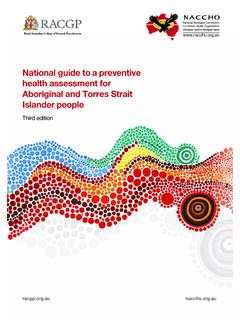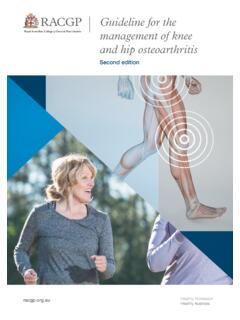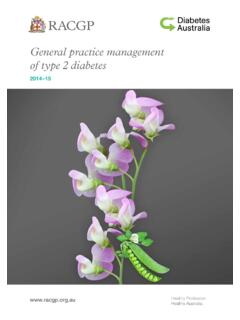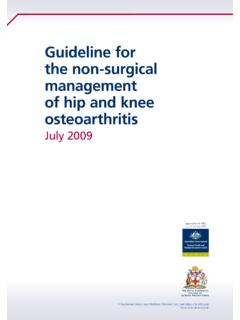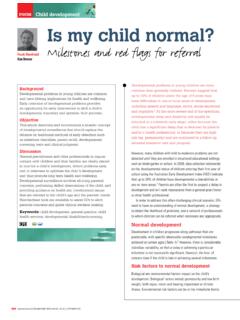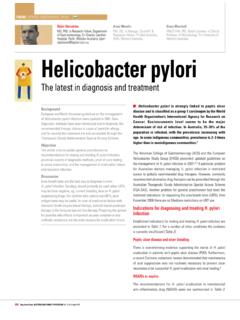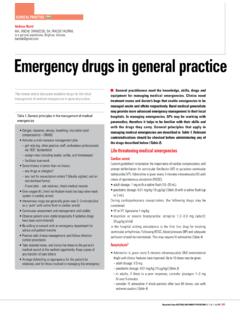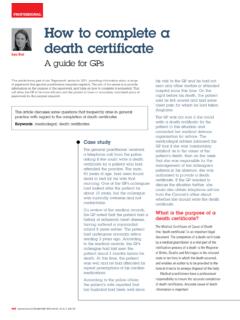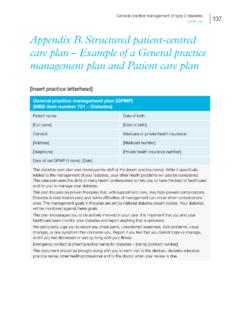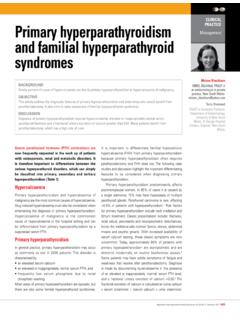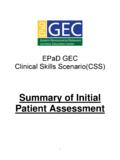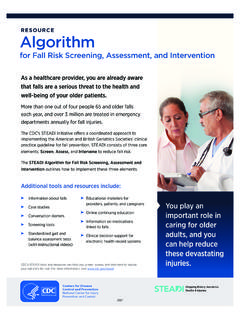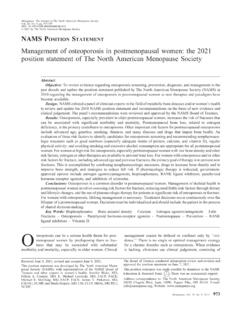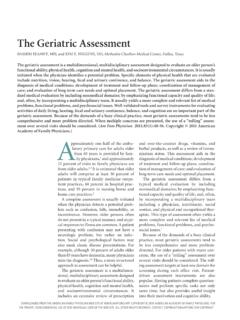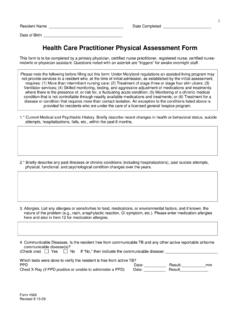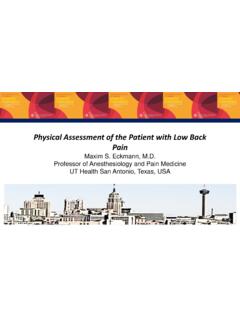Transcription of Osteoporosis risk assessment, diagnosis and management
1 Osteoporosis risk assessment , diagnosis and management Recommendations restricted to postmenopausal women and men aged >50 yearsPractice tipsDiagnosisA minimal trauma fracture of the hip or spine in a person older than 50 years of age is presumptive of Osteoporosis (Recommendation 1 A). Treatment may be initiated without confirmation of low bone mineral density (BMD). Use BMD to guide management after fracture at other vertebral fracturePerform a standard spine X-ray if height loss of 3 cm, kyphosis or unexplained episodes of back pain. If vertebral wedge or crush fractures are detected, perform BMD testing at the hip and absolute fracture riskUse the Garvan Fracture Risk Calculator ( ) or Fracture Risk assessment Tool (FRAX) ( ) to assess the need for treatment in individuals who do not clearly fit established criteria (Recommendation 6 D).
2 Calculator estimations assist, but do not replace clinical preventionA full falls risk assessment should be conducted in any person who has fallen twice or more in the previous 12 months or is having difficulty with walking or balance. A multifaceted fall prevention program should be tailored to individual needs (Recommendation 10 A).Calcium and vitamin D supplementationRoutine supplementation in non-institutionalised individuals is not recommended. Those at risk of deficiency may benefit from 500 600 mg/day of elemental calcium. Calcium supplements are recommended for people taking Osteoporosis treatments if dietary calcium intake is below 1300 mg/day (Recommendation 14 C) and vitamin D if serum 25(OH)D is below 50 nmol/L. ExerciseLeisure walking, swimming and cycling do not improve bone density.
3 Prescribe regular, varied, high-intensity resistance training and progressive balance training (Recommendation 11 A). High-impact activities should be avoided by individuals at high risk of fracture. Avoid forward flexion and twisting in vertebral Osteoporosis . Programs should be individualised and may require of therapyIf T-score remains below , and/or there are incident vertebral fractures, continue treatment. Reconsider therapy after 5 10 years in individuals with T-score and no recent fractures. Treatment should be restarted if there is continued bone loss or a further minimal trauma fracture (Recommendation 17 D). Repeat BMD testingRepeat testing is generally not required for confirmed Osteoporosis , unless a medication change or interruption is planned.
4 Test a minimum of two years apart, less frequently in low-risk individuals. Annual scans may be needed in high-risk individuals (eg those on glucocorticoid therapy). Medication-related osteonecrosis of the jaw (MRONJ)The benefits of Osteoporosis treatment for those at high risk of fracture far outweigh the risk of MRONJ (between <1 and 10 cases per 10,000 patients). Optimise oral hygiene and treat dental disease prior to therapy. There is insufficient evidence to interrupt therapy for minor oral surgery, or to measure bone turnover markers to predict onset of guide is based on Osteoporosis prevention, diagnosis and management in postmenopausal women and men over 50 years of age, 2nd edition. For the full list of evidence-based graded recommendations, practice tips and background information, access the full guideline from Osteoporosis Australia or The Royal Australian College of General Practitioners for patientsInformation for healthcare professionalsOsteoporosis Australia Osteoporosis Australia Know Your Bones NPS MedicineWise Bones Australia Therapeutic guidelines : The information in this summary is not to be regarded as individual clinical advice, and is no substitute for full medical examination and consideration of medical history.
5 Osteoporosis Australia and The Royal Australian College of General Practitioners accept no liability to any persons for any loss, damage, or costs arising from the use of the information in this publication. Osteoporosis Australia and The Royal Australian College of General Practitioners risk factor profile (Grade B) Major risk factors that qualify for MBS reimbursement of DXA Minimal trauma hip or vertebral fractureMinimal trauma fracture at any other site*No history of minimal trauma fractureDXA of spine and proximal femur (Grade A) Osteoporosis risk assessment , diagnosis and management Recommendations restricted to postmenopausal women and men aged >50 yearsInitiate treatment with anti- Osteoporosis medication Bisphosphonates (Grade A) Denosumab (Grade A women, Grade B men) Oestrogen replacement therapy (Grade A) Strontium ranelate second line only (Grade A)
6 Initiate treatment with anti- Osteoporosis medication Bisphosphonates (Grade A) Denosumab (Grade A women, Grade B men) Oestrogen replacement therapy (Grade A) Strontium ranelate second line only (Grade A)Refer for specialist reviewDXA to establish baseline BMD recommended but not essentialBMD Bone mineral densityDXA Dual energy X-ray absorptiometryHIV Human immunodeficiency virusMBS Medicare Benefits ScheduleMGUS Monoclonal gammopathy of undetermined significancePPIs Proton pump inhibitorsSSRIs Selective serotonin reuptake inhibitor* Excluding fingers and toes Qualifies for MBS reimbursement of BMD testing Consensus recommendation. The MBS reimburses costs for measurement of BMD testing in any person aged 70 years || See other guidelines specific to glucocorticoid treatment for more information and recommendations regarding glucocorticoid use and risk of Osteoporosis and fracture Treatment of an underlying condition may improve bone strengthDXA of spine and proximal femur (Grade A)
7 Non-modifiable Parental history of fractureModifiable and lifestyle Premature menopause Hypogonadism Multiple falls Low physical activity or immobility Low body weight Low muscle mass and strength Poor balance Protein or calcium undernutrition Smoking Alcohol >2 standard drinks/day Vitamin D insufficiencyEstimate absolute fracture risk Garvan Fracture Risk Calculator or FRAX (Grade D Consensus)Aged 70 years (Grade D Consensus)Diseases or conditions Rheumatoid arthritis Hyperthyroidism Hyperparathyroidism Chronic kidney disease Chronic liver disease Coeliac disease or malabsorption Diabetes mellitus Myeloma or MGUS Organ transplant Bone marrow transplant HIV infection DepressionMedications (large effect) Glucocorticoids || (>3 months mg/day) Excess thyroid hormone replacement Aromatase inhibitors Anti-androgen therapy Medications (modest effect) SSRIs Anti-psychotics Thiazolidenediones Anti-epileptic medications PPIsT-score > sWhere appropriate Implement falls reduction strategies (Grade A) Encourage exercise participation (Grade A) Modify diet, smoking and alcohol intake (Grade C) Provide education and psychosocial support (Grade D)Where appropriate Implement falls reduction strategies (Grade A) Encourage exercise participation (Grade A) Modify diet, smoking and alcohol intake (Grade C) Provide education and psychosocial support (Grade D)
8 High 10-year risk of fracture Hip fracture >3%, any fracture >20%OR T-score risk of fractureTreatment not recommended4428
